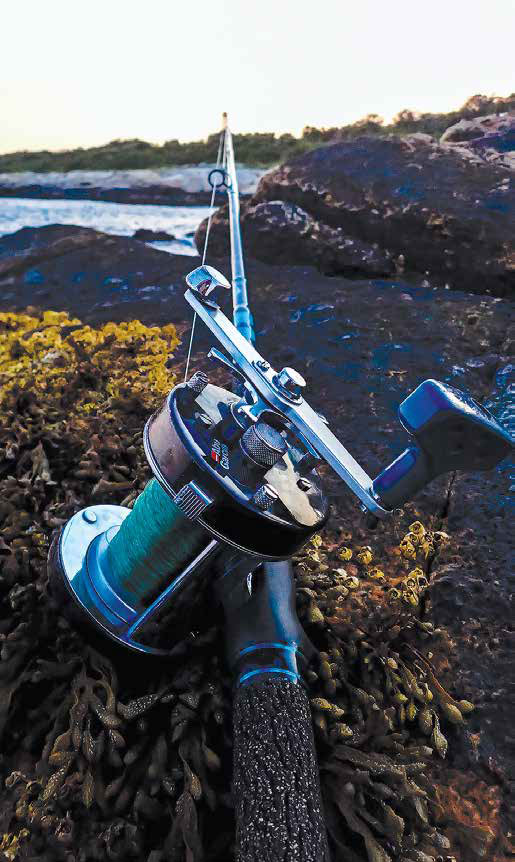
I use conventional reels in the surf not because they are the best tool for the job but because I own a fair number of them. Maybe I’m stubborn, but I can’t picture using anything else, despite the obvious fact that a sealed spinning reel is the right choice when standing in the water amongst the boulders fishing a night tide.
A well-tuned conventional will sing to you on every cast—and they will let you know, conversely, when a cast doesn’t go as planned. You can run on auto-pilot with a spinning reel but not so much with a conventional. Each cast needs a slight pause, a slight moment of awareness. That’s the skill and joy of it.
I tune my reels for reliability—I have no fetish for distance. My fish tend to come to me inside of 50 yards, less than that quite often, and I concentrate my efforts in this narrow band of water. I almost always fish at night and because of this I tend to want my reels to be slow and controllable instead of super fast the way a lot of distance throwers rig them. At night everything is more difficult: it’s harder to time when your lure is about to hit the water to stop the spool from spinning; harder to see if you’re laying the line on the reel evenly; harder to get proper footing, with each foot braced so you can swing the rod smoothly through the motion.
The only way to be a competent night-time conventional surfcaster is to train your thumb. You can’t really rely on the perfect balance of magnets and brake blocks and bearing oil—the situations in surf fishing change too much. One spot the wind is at your back, and the next it’s in your face. One cast you’re using a 3-ounce needle and then you switch to a 1-1/2-ounce Danny. Perhaps some eels in the bag are perfect but some are shoe-strings. It’ll drive you nuts trying to figure out at home how to tune the reel based on the weights and expected conditions. So I tune them all the same.
The Partial Breakdown
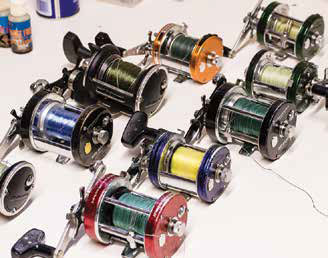
I rarely do a full breakdown even if I completely fill the reel with saltwater. I also don’t pack the reels with grease like some guys do who are trying to make their 704s and 706s watertight. I do partial breakdowns, focusing on the three bearings and the main drive gear. A complete teardown takes more time and involves pulling all the springs and clutches off the break plate. If the break plate looks good with plenty of grease then I leave it until the next time or the next time after that.
My whole philosophy with this is speed. I can do a breakdown in about 15 minutes. I have kids and a home and work and a wife who works and who often hands me a lengthy and complex “chores” list. Fishing time—according to my wife–is any time my hands come in contact with anything to do with fishing. This includes working on reels. So I’m quick. Am I perfect at this? No. Do I always use the right oil or grease or solvent on the right part? No. But my reels work well and show very little signs of corrosion—many are over 15 years old.
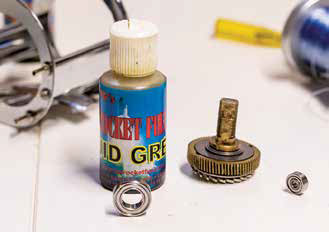
I take the reel down and pull the two spool bearings and main gear bearing, which is the bearing on the crank. I soak these in brake cleaner, the one in the green can (Some use lighter fluid for this.). While those are soaking I take apart the whole drive shaft assembly and lay out all the washers in the order I pulled them. I wipe the washers down and dry them. I use my washers dry, except I grease the washer that sits under the main gear. With the main gear off the brake plate, I inspect the brake plate. The brake plate on an Abu has three springs, a clutch arm and a lock arm. If you ever need to take this down then take some photos with your phone before you take the springs and clutches off.
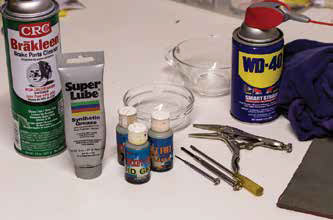
I always clean and re-grease the teeth on the pinion gear that meshes with the main gear. I use the grease and quickly work the grease so that every space in the gear has some grease in it. I also put a thin coat of grease up the crank and put the washers back in their place. The only drag washer I grease is the first washer that goes in, the one that rides underneath the main gear. All the other washers (I use Carbontex fiber washers.) I run dry.
During this whole breakdown process every part I’m quickly hitting with my rag. This rag, which has decades of reel grease and oil in it, acts, I believe, as an excellent corrosion protector. I love my rag, like a kid with his or her little blanket. I continue re-assembling the reel, putting the side plates back on the main frame. The Abu side plates, with all their colors I want to protect. So I hit these, both inside and out, with the rag and some oil.
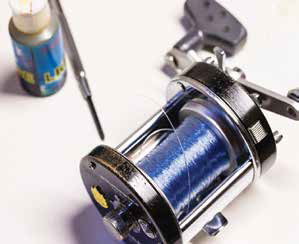
I take the bearings (I use ABEC bearings.) out of the brake part cleaner and spin them. If they seem noisy or sticky I put them back in for another soak. When the bearings “feel” right I leave them to dry, tilted upwards. I used to use a hair dryer and probably still should. The hair dryer not only dries the bearings it heats them up so when you add the new bearing oil, it flows smoothly. After the bearings are dry I add oil and replace them in the reel.
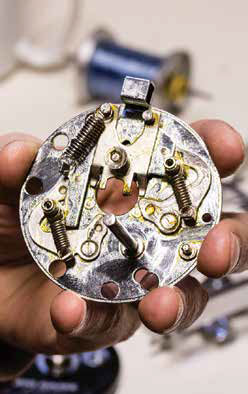
I use oils from TG’s, the maker of high-speed reel oils, like the popular Red Label. However there are two other oils by them that I use a lot: the XS and the Liquid Grease. I use the XS on the spool bearings and the liquid Grease on the main bearing. These are a lot more viscous than the Red Label, and the XS in the spool bearings helps slow the reel down and make them very easy to cast with eels and chunks. My plugging reels I tend to use the fast oils like the Red Label.
Backlashes tend to happen within the first few seconds of a cast—which is a sign of bad technique or near the end of the cast, which is a sign of the spool revolving faster than the speed of the bait or lure. A slower reel, with oil and a brake-block or two helps the latter, and practice helps with the former. The key to a good cast is being smooth with the rod. I tend to use softer rods, like the Lamiglas GSB-series. Although they are not the sticks favored by distance casters they are more forgiving in the surf, when many different eel and bait weights are being thrown on a given tide.
There is something special about fighting a heavy striped bass on conventional tackle in the surf. The feel of the battle, the connection with the fish’s every move, the control the angler can have on the fish; none of these quite feel the same when fishing with spinning gear.




